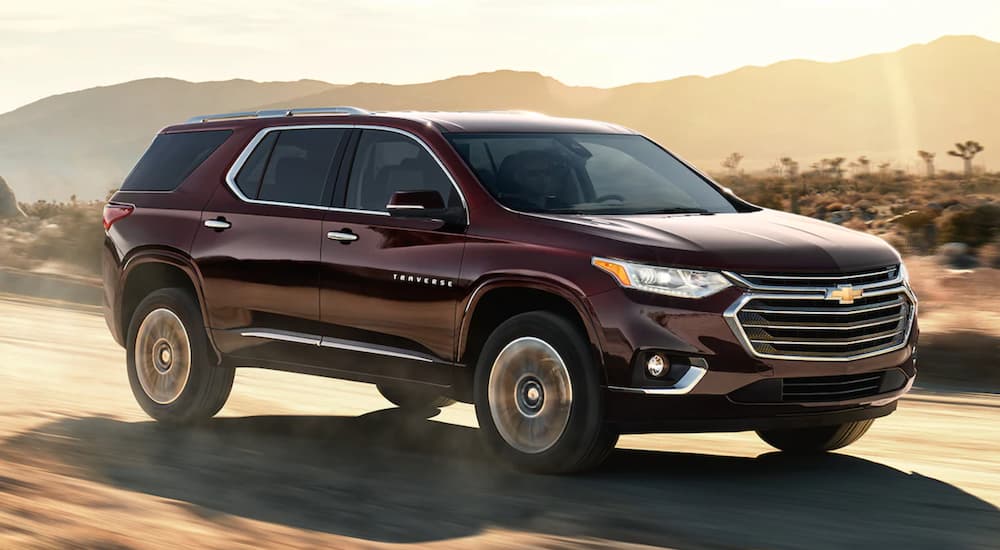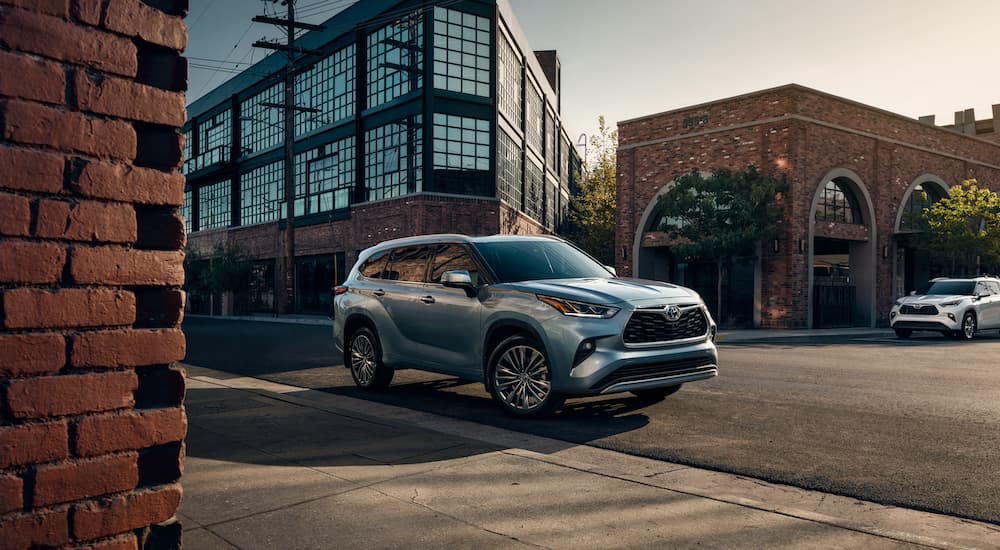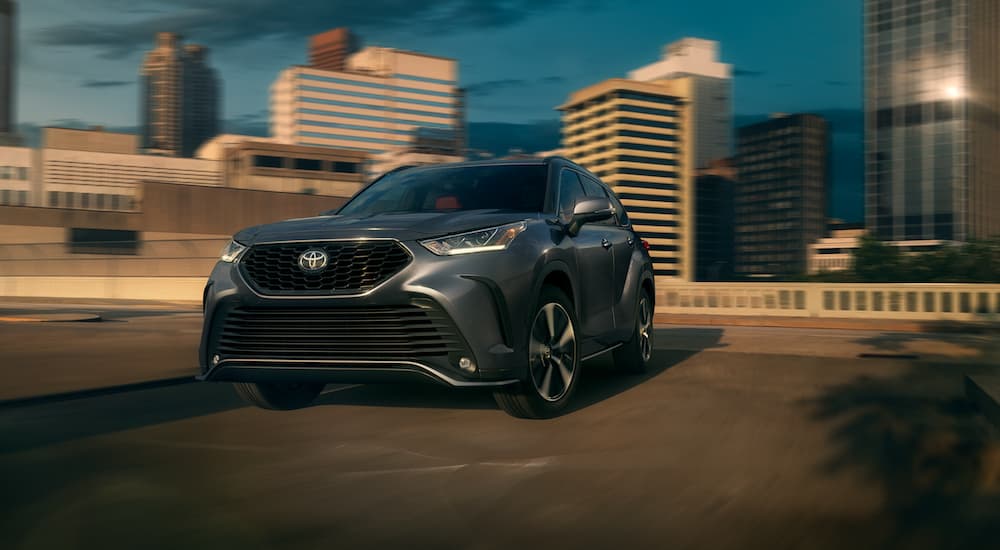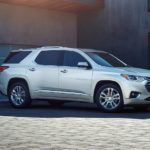There are a lot of opinions to consider when picking out a family SUV, and it can be difficult to satisfy everyone’s demands. Mom wants something fuel-efficient and easy to park, whereas dad is more concerned about being able to haul the boat up to the lake. The kids might not get much of a say unless they’re willing to forgo a couple of years of allowance to chip in on the down payment, but it’s still in everyone’s best interest to keep them happy as well, so throw safety and tech features on the list as well. With so many options on the market these days, it can be intimidating, but a few models rise above the competition. Let’s narrow it down to two and a little in-depth analysis between two leaders in the market segment: the 2021 Toyota Highlander vs 2021 Chevy Traverse.
Room for Growing Families
First off, a little background. Introduced in 2009, the Traverse was Chevy’s well-received entry into the mid-size crossover market. The SUV won early accolades for its ample cargo and passenger space, and for the most part, has stuck to that winning formula with a design that emphasizes roominess above all else.
Toyota has capitalized on the same consumer demand for a spacious family SUV with the Highlander. Redesigned with a longer, wider chassis in 2013, the mid-size SUV saw even more cargo room added in 2019 and now rivals the Traverse for overall interior space. Both SUVs can accommodate up to eight passengers across three rows with an optional bench seat or seven if one opts for second-row captain’s chairs.
When it comes to overall dimensions between the Highlander and Traverse, there’s not much to separate the two. The Traverse has a roomier third row and 98 cubic feet of cargo capacity against 84 cubic feet for the Highlander, but it’s a trade-off. The extra cargo space is certainly useful in many scenarios but also leads to a bulkier vehicle in general that might present issues when it comes to maneuverability and parking. In the end, it’s a matter of priorities, with drivers free to choose between passenger/storage space and overall size.

Highlander Stands Out With Superior Powertrain Customization
Consumers will find very little to separate the power and performance on the base models of these two family-friendly SUVs. The Traverse and Highlander clock in with nearly identical torque and are almost as inseparable in terms of horsepower at 310 and 295 hp, respectively. They also stack up well when it comes to towing capacity, with each V6-equipped base model rated to carry up to 5,000 pounds.
While the Traverse has been cited for its strong acceleration, consumers will be stuck with a single powertrain option. In contrast, the Toyota is available with a hybrid powertrain capable of producing 243 horsepower, all while saving precious pennies at the pump. The hybrid model of the 2021 Highlander boasts an impressive estimated 36 MPG city and 37 MPG highway, using regenerative braking to bring city performance nearly on par with highway driving. Available in both front-wheel and all-wheel drive, the hybrid model Highlander does sacrifice 1,500 pounds of towing capacity to its gas-powered cousin, but with rising gas prices, that’s a trade-off many drivers won’t mind. The base model Highlander gets around 21 MPG city and 29 MPG highway which, while not at the level of the hybrid, still blows away the Traverse at 18 MPG city and 27 MPG highway.
The Highlander also benefits from the inherent advantage in electric motor-driven powertrains: instant torque. Without cylinders to get fired up, the power transfer on a hybrid (or electric) vehicle happens the moment you step on the pedal, allowing for precise acceleration that delivers a high-performance feel to everyday driving.
There are a few other creature features that separate the Highlander and Traverse. Chevy’s SUV includes a Driver Mode Selector option which allows drivers to switch between a number of dedicated configurations depending on usage. These range from front-wheel drive and all-wheel drive to off-road mode and a tow/haul option.
The off-road option, for example, shifts extra torque to the rear wheels of the Traverse, making it an ideal option for a little light off-roading. For its part, the Highlander includes an advanced all-wheel drive system on some upper trim packages. Designed to aid in cornering and off-road capacities, Toyota’s Dynamic Torque Vectoring All-Wheel Drive can funnel extra power to individual wheels using an electromagnetic coupling linked to the SUV’s rear differential, ensuring a solid grip no matter the road conditions.
Keeping the Whole Family Safe and Entertained
These days we’re asking for more out of our vehicles than ever. It’s not enough to be able to hurtle ourselves down a road at 70 mph in a marvel of modern engineering; it also needs to be able to charge our phones, tell us exactly where to turn, and keep the kids quiet in the back seat. In this arms race to pack as many cutting-edge features as possible into our vehicles, both Toyota and Chevy have come ready to compete.
The center console touchscreen is a ubiquitous feature on nearly all of today’s new vehicles, and these two are no exception. The Toyota Highlander takes a decided lead in this category, with not only a larger 8-inch touchscreen on the base model but the option to upgrade to an industry-leading 12.3-inch behemoth that looks more like a full-size iPad tacked to the dash. The Traverse, on the other hand, comes with a 7-inch screen standard and an available upgrade to 8 inches, making the Highlander the clear winner in the screen wars.
Both mid-size SUVs include the expected suite of apps and tech features, like voice recognition, Bluetooth, Apple CarPlay, and Android Audio, but the Highlander wins out by throwing Amazon Alexa and SiriusXM in as standard features as well. This difference will become especially stark a couple of months into ownership when many of the free trials included with the Traverse’s infotainment system start to dry up, and you begin to get a better picture of just how well-appointed the Highlander is.
Of course, safety is really the primary watchword when it comes to any family vehicle. The tech features might be useful and novel, the powertrain ample and responsive, but they both pale in comparison to keeping your family safe on the road. As automated safety technology improves, these features are becoming more common across the industry, but some brands are adapting more quickly than others.
Toyota, for one, is not resting on its laurels when it comes to next-gen safety features. With an impressive suite of driver-assist technology branded as Toyota Safety Sense 2.5+, the Highlander is thoroughly modern in its teach-centric approach to safety. The system’s automated features range from the Pre-Collision System with Low-Light Pedestrian Detection to Full-Speed Dynamic Radar Cruise Control, Lane Departure Alert with Steering Assist, Automatic High Beams, and Road Sign Assist.
Chevy isn’t far behind in the safety game; it’s just not quite as apt to include many of these features standard. Mid to high-end trim packages of the Traverse include many of the automated features found on the Highlander, like Automatic Emergency Braking, Front Pedestrian Braking, Forward Collision Alert, Lane Keep Assist, and Adaptive Cruise Control. Both vehicles do include a full 360-degree camera array, giving drivers the ability to see a stitched-together image of their surroundings that make parking, lane changes, and merging a distinctly less stressful task.
Parents will appreciate Chevy’s Teen Driver technology, which allows them to set limits and alerts when their child is behind the wheel. These features include speed warnings and limiters, a stereo volume limit, and two different methods of ensuring the driver is buckled. One is a buckle-to-drive feature that disables the shifter until the belt is fastened while the seat belt audio mute approach weaponizes a teen’s most valuable asset – their playlist – preventing any audio playback until everyone is buckled in. The Teen Driver technology can also be used to produce a driving report card that provides an in-depth analysis of your teen’s driving habits, giving parents some valuable peace of mind.
The Choice Is Yours
Drivers choosing between the 2021 Toyota Highlander and the 2021 Chevy Traverse have a lot to consider. While the Highlander bests the Traverse in categories related to safety, performance, and fuel efficiency, those who are primarily concerned with having enough room to accommodate an ever-expanding schedule of youth soccer carpools will appreciate the Traverse’s focus on space. In the end, it’s up to each consumer to decide exactly what they want out of their next vehicle, but for our money, the long list of features that come standard, as well as the customizable powertrain and superior fuel efficiency, make the 2021 Toyota Highlander our clear choice as one of the best mid-size family crossover SUVs currently on offer.





